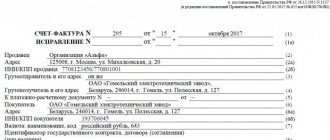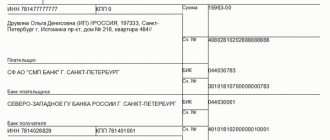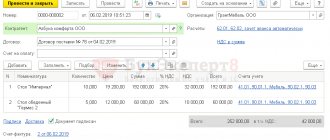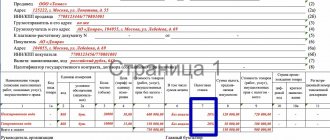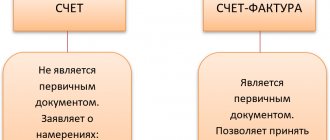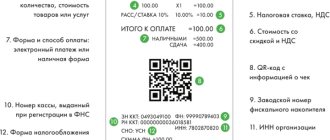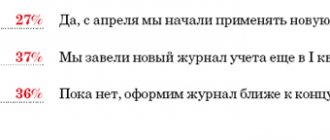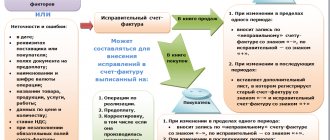In this article we will look at what kind of document this is - an invoice and what it reflects, what it is used for and who will need it in the work of the enterprise. Without it, it will not be possible to confirm that the products were delivered in full and there are no complaints against the supplier. This paper has a clearly defined structure from which you cannot deviate, otherwise it will cease to have legal force. Also, the document is important for completing the transaction, so it is very important to draw up everything correctly. Now there are many programs that help automatically create and even fill out fields for this documentation. Accountants can only check the correctness and sign.
What is an invoice, why is it needed and who does it belong to - sample
This is a document that is kept by accountants. It confirms that the goods were actually shipped to the buyer or services were provided, and the cost of the products is also stated there.
This paper is sent to the buying party simultaneously with the shipment sent for sale or by mail. Another option is to bill after the products or services have been accepted.
It is important to respect the format in which the invoice will be created and offered. It was approved by a government decree, so you cannot swap fields or create your own spellings, even if they are enshrined in the charter and order of the director of the enterprise.
Types of invoices found in accounting
There are only two of them. The first is called the standard SF. It is created when a shipment has been shipped or work has been completed for which the buyer now owes money. It is necessary when the products are fully paid for. Time for preparation and sending is 5 calendar days from the date of transfer. The same is given if the products were returned back to the supplier.
The second type is advance payment. It should be prepared if prepayment is required or has been credited to the account for future shipments. Here you do not need to fill out fields such as:
- shipper;
- cargo receiver;
- volume of goods or services received;
- units in which everything will be measured.
But be sure to include everything that will be needed later for calculations.
When an invoice is not needed
The legislation specifies cases when an invoice is not a mandatory document, and the completion and execution of a transaction is confirmed by other data: an invoice, an invoice for payment. Based on the regulations, the invoice is not filled out under the following circumstances:
- the transaction is not subject to VAT (Articles 149 and 169 of the Tax Code of the Russian Federation);
- when selling goods for cash (in this case, a check or a strict reporting form is sufficient);
- when applying simplified taxation regimes;
- a legal entity - an employer transfers goods to its employee without providing counterpayment, that is, free of charge (according to Letter of the Ministry of Finance of the Russian Federation dated 02/08/2016 No. 03-07-09/6171);
- when sending goods for export, taxed at a zero rate, if the buyer is not a VAT payer, if the shipment took place no later than 5 calendar days from the date of receipt of the advance payment (according to Letter of the Ministry of Finance of Russia dated January 18, 2017 No. 03-07-09/1695).
VAT
When the transaction is paid, the seller charges value added tax. SF will be considered as confirmation of the transaction for payment for products; this is recorded in a specialized book. Based on the received invoice, the relevant data in the declaration will be filled in.
If there are no errors in all the papers and everything is done correctly, then the buyer has the opportunity to request a tax deduction under this article.
There are situations when VAT will not be charged. For example, entrepreneurs who work under the simplified tax system do without this. But quite often, without looking at these circumstances, the buying party asks to be given an invoice, even if VAT is not included in it.
Of course, this is not an obligation that the seller must fulfill. But usually they meet halfway and draw up a SF. The only peculiarity is that the document immediately states that the purchase was without value added tax. Accordingly, this line in the form will remain blank.
An important nuance - if the selling party is not a VAT payer, then it cannot enter 0% in this field. This is a separate category of enterprises to which defaulters do not belong. Even 0% is a realistic rate that these firms are not entitled to. If you need to enter something, it is better to indicate “Without VAT”. This will be true and will not invalidate the document, unlike 0%.
If you enter inappropriate data, then this will become a problem for the recipient of the paper. Inspection authorities issue a fine or charge the standard 18-20%.
Do you want to implement “Store 15”? Get all the necessary information from a specialist.
Thank you!
Thank you, your application has been accepted.
What details can’t you do without?
All conditions were specified in Article 169 of the Tax Code. In order for the SF to be accepted for registration and studied, it must contain certain lines:
- The day on which the document was drawn up, and the serial number upon creation. The number is the one on which the transaction took place. Any numbering that the seller likes. The main thing is that the numbers should go in ascending order and remain consistent. But if the company violated the system and after 55 and 56 issued SF No. 22, then this will not affect the tax deduction in any way.
- The name of the selling organization, full address and all important identification numbers. Everything must be correct, without corrections or errors, easy to read and in a normal font. The abbreviated or full form must be made in such a way that it corresponds to the constituent documents and is consistent with the charter of the company. You can't do without a postal code.
- Everything is spelled out similarly on the buying side. You must correctly indicate where the client is located and where the shipment will be shipped. These lines may be of interest to the tax service.
- Recipient and sender of the cargo, their addresses. This information is necessary when selling products. When work is being performed or a service is being provided, such a line is not needed. When selling goods, you do not have to fill out this field completely. But if you write all the details, then it won’t be an error. The recipient must be described completely in accordance with the statutory documents. In this case, it does not depend on whether the buyer is the consignee or not.
- The name of the products sold, the units in which they are measured. You cannot make mistakes in these fields. It is important to write correctly whether products are counted in pieces, kilograms or liters.
- The number of products that were sold or the volume of services provided. This line indicates how many parts or watermelons were eventually sold to this buyer. The calculation and the total amount depend on this part.
- Price or tariff. Counts as a unit of measurement, if possible. Indicated without VAT or including it, depending on what is specified in the contract.
- Paper currency. How everything is calculated and payment will be made. A code is written that is listed in the All-Russian Classifier. It can be a ruble (643), a dollar (840), euro (978) or any other official currency.
- The total cost of products sold. Be sure to carefully calculate and indicate. Errors and adjustments are not allowed. More often, a document is prepared electronically, and all fields are filled in automatically, so the risk of making a mistake tends to zero.
- Tax rate. It could be 0%, 10% or 20% depending on how the company operates and what it sells. If the company is on a simplified basis or has been completely exempted from calculating and paying value added tax for any reason, then “Without VAT” is written in this line. We have already discussed above how this works and why it is recommended to write correctly.
- The amount of tax calculated. As a rule, programs calculate it automatically; accountants can calculate it manually.
- The full cost for the volume of products or services sold, including tax.
- The country in which everything was produced and the number from the customs declaration. This line is only relevant for goods that were sent from abroad.
You can simplify and optimize business processes using special software. On the Cleverens website you will find solutions suitable for various purposes and tasks.
Electronic invoices
SF, according to the Tax Code, can be issued to the counterparty on paper or electronically.
Electronic invoices - this option can be implemented under the following conditions:
- the presence of mutual consent of the parties to the transaction;
- availability of technical capabilities for accepting and processing electronic SFs.
Electronic invoices (ESI) must be signed with an enhanced qualified electronic signature of the manager (or other authorized person).
This signature is created (programmed) using special cryptographic (encryption) tools. The authenticity of the signature is guaranteed by a certificate issued by a certification authority.
Electronic invoices signed with an enhanced qualified electronic signature have the same legal force as a paper document signed manually.
Important: from July 2021, the form of electronic SFs has changed. Therefore, those who use this form of document management (what is it?) need to update the software.
Why do we need paper such as an invoice in the purchasing department and in the accounting department?
First of all, it will be needed to confirm the output VAT when services and products are sold. And later it will be useful to write off the input value added tax at the time of purchase. It will serve as proof of the transaction that took place.
When an outgoing SF is registered, it is entered into the Sales Book. When incoming - from the seller - then in the Purchase Book. As a result, the data in the declaration will be filled out based on the information that is generated in these documents.
If an advance payment is transferred, and the product arrives to the buyer later than 5 days, then an advance SF should be issued. It will confirm the fact of the transaction and will prove to the buying party that they purchased the product or service. If errors are later identified in it, then an additional, corrective SF can be written out.
For an accountant, these are papers that help keep records, confirm current business transactions and are an opportunity to receive a deduction.
Definition of the concept in simple words: what is it and why?
Why is this document needed? An invoice is an accounting document that does not belong to the category of primary accounting documents , designed to provide additional control over the correct calculation of VAT, that is, value added tax, which must be paid by a business entity to the state budget. There is a unified form of this paper.
Please note that the legislation establishes a clear procedure both regarding the preparation of such papers and the need to record them in special journals (books).
The Tax Code of the Russian Federation, or more precisely, Articles 168–169, establishes the rules for the use of this document.
An invoice is issued by the seller of the goods, as a rule, for wholesale purchases, to the buyer. Also, the document is drawn up when carrying out any orders in the accounting department.
These include:
- a sales book maintained by the seller of a product, recording data on the products (services) sold;
- a purchase book, where the buyer notes information about the purchased product (service).
By the end of the reporting period, the information entered monthly in the accounting books is summarized to calculate VAT to be transferred to the state budget.
In accordance with the rules of Russian grammar, the phrase “invoice” should refer to the masculine gender, not the feminine gender (according to the first word).
In simple words, an invoice is a document confirming that:
- what (name of product or service), as well as in what quantity is sold by the seller, what is the cost of these goods (services) and what amount of VAT tax will be charged for transfer to the budget, in this case.
- what amount the buyer is entitled to receive as a tax deduction, since it is paid by the seller of the goods (services).
Important! An invoice cannot serve as evidence of the fact that the seller has transferred the goods to the buyer; this is intended for a bill of lading or an act of acceptance and transfer of material assets issued to the buyer. A payment and settlement paper or a cash receipt must be attached to the document itself.
The main types of document are:
- an invoice, which is issued when the supply of goods or provision of services occurs simultaneously with their payment by the recipient;
- advance SF, which is required in case of prepayment for goods (services);
- corrective SF, which is intended to correct erroneous entries.
Video about what 3 types of invoices the Tax Code provides for:
Procedure for filling out an invoice
We discussed above which fields need to be filled out. Now let's go through the lines:
- (1). There will be a date and number here.
- (2), (2a), (2b), (6), (6a), (6b). Name, addresses, tax identification number and checkpoint of the buying and selling parties. Everything is in accordance with the constituent papers and charter, even if it is written in an abbreviated form.
- (3), (4). The name and postal address that are indicated for the recipient and sender of the cargo. For the SF, which is prepared on the basis of works or services, a dash is placed in this field.
- (5). The date and number that was assigned to the payment document if an advance was given. When it was not issued or was not monetary, a dash is indicated.
- (7). What is the name of the currency and its code. Even if a company has always operated exclusively in rubles, this is written anew in each Federation Council. There should be no ambiguity or other options.
- Table with graphs. In column 1 the name of the products currently being sold and as it was written in the contract or invoice.
- Column 2, 2a, 3, 4. Code and designation of what the product is measured in, volume, cost excluding VAT.
- Column 6. The amount of excise tax or the phrase “without excise tax” depending on the type of product.
- 7, 8. The size of the tax rate and how much it amounted to in rubles and kopecks is not rounded to whole numbers.
- 5, 9. Total cost of everything sold. In the first case, without VAT, and in the second - already taking into account the accrued tax. It is registered twice even if the company operates without VAT.
- 10, 10a, 11. It is necessary to fill out only if the company sells or resells imported goods.
At the end, the head of the organization or his authorized person must sign - usually an accountant. Below is a seal that certifies the correctness of all filled fields.
Is an invoice proof of proper provision of services?
In accordance with Art. 779 of the Civil Code of the Russian Federation, under a contract for the provision of paid services, the contractor undertakes, on the instructions of the customer, to provide services (perform certain actions or carry out certain activities), and the customer undertakes to pay for these services. The general provisions on contracts and household contracts apply to an agreement for the provision of services for a fee, unless this contradicts the provisions of Art. 779-782 of the Civil Code of the Russian Federation, as well as the peculiarities of the subject of the contract for the provision of paid services (Article 783 of the Civil Code of the Russian Federation).
According to the provisions of Art. 309 of the Civil Code of the Russian Federation, obligations must be fulfilled properly in accordance with the terms of the obligation and the requirements of the law, other legal acts, and in the absence of such conditions and requirements - in accordance with business customs or other usually imposed requirements. Unilateral refusal to fulfill an obligation and unilateral change of its conditions are not allowed, except for cases provided for by law (Article 310 of the Civil Code of the Russian Federation).
The delivery of the work result by the contractor and its acceptance by the customer are formalized by an act signed by both parties. If one of the parties refuses to sign the act, a note to this effect is made in it and the act is signed by the other party. A unilateral act of delivery or acceptance of the result of work can be declared invalid by the court only if the reasons for refusing to sign the act are recognized by it as justified (clause 4 of Article 753 of the Civil Code of the Russian Federation).
When establishing the proper form of the acceptance and transfer certificate, the courts, as a rule, turn to the Resolution of the State Statistics Committee of Russia dated November 11, 1999 No. 100 “On approval of unified forms of primary accounting documentation for recording work in capital construction and repair and construction work.” This act approved, in particular, the forms of acceptance certificates for completed work (form KS-2). If the controversial work and services cannot be classified as construction and/or repair work, the work (service) acceptance certificate, if the parties do not agree on its form, is drawn up in any form.
According to Art. 9 of the Federal Law of December 6, 2011 No. 402-FZ “On Accounting”, all business transactions carried out by an organization must be documented with supporting documents that serve as primary accounting documents in accordance with which accounting is kept. In accordance with paragraph 1 of Art. 169 of the Tax Code of the Russian Federation, an invoice is a document that serves as the basis for the buyer to accept the goods (work, services), property rights presented by the seller (including the commission agent, agent who sells goods (work, services), property rights on their own behalf) tax amounts to deduction in the manner prescribed by the Code.
Thus, the issue of preparing primary accounting documents is important for business entities. The use of documents whose forms do not comply with established requirements may lead to adverse consequences for them. Meanwhile, invoices themselves cannot serve as confirmation of the provision and acceptance of services (performance of work). Such documents are drawn up by the company in order to comply with the norms of the Tax Code of the Russian Federation on the allocation of VAT amounts on transactions and cannot replace the documents required when the parties formalize civil legal relations.
For a long time, in judicial practice there was no uniform approach to establishing the meaning of an invoice when proving the fact of provision of services, performance of work or delivery of goods. In some cases, the courts stated that an invoice in the absence of an acceptance certificate cannot confirm the relevant legal facts (see, for example, the decisions of the FAS Volga-Vyatka District dated January 15, 2010 in case No. A29-2737/2009, FAS Moscow District dated January 27, 2010 in case No. A40-57326/09-103-207). In others, on the contrary, invoices and delivery notes were considered as adequate evidence of the transfer of goods or the provision of services (work). Thus, in the Determination of September 21, 2011 No. VAS-11726/11 in case No. A81-2454/2010 (on the refusal to transfer the case to the Presidium of the Supreme Arbitration Court of the Russian Federation), the Supreme Arbitration Court of the Russian Federation indicated that the fulfillment by the company "Unikonprofstal Engineering" of obligations to supply goods to the amount of 13,361,984 rubles. confirmed by the corresponding invoices and invoices, which served as the basis for satisfying the claim of the Gloria Bouquet company for the return of the amount of advance payment for goods not transferred by the seller.
Recently, courts have again leaned towards the first approach. Thus, in the resolution of March 14, 2018 No. F05-645/2018 in case No. A40-46895/2017, the Moscow District Court stated that invoices do not prove the provision and acceptance of services (performance of work). They are drawn up in order to comply with the requirements of the Tax Code of the Russian Federation and do not replace the documents necessary when the parties formalize civil legal relations. At the same time, the court also noted that if the parties did not draw up bilateral acts of acceptance of the work (services) performed and a dispute arose between them on the issue of the cost of services, then the claim for recovery of the cost of services provided can be satisfied upon establishing the volume of services actually provided and their actual cost.
Thus, you have the opportunity to obtain payment for the services you provided even in the current situation. However, to do this, you will have to provide additional evidence of the fact of their provision in addition to invoices. In this case, we may be talking about submitting to the court the results of such services, your correspondence with representatives of the counterparty. We also recommend that before going to court, you still send the customer a signed acceptance certificate for the results of services, as provided for in the concluded contract.
Log books and books
These are mandatory attributes of the functioning of any organization. Each taxpayer is required to draw up a tax return and maintain this documentation when transactions are eligible for taxation.
This is how VAT is calculated in cases of sales of products, provision of services or transfer of property rights. The selling party must register the issued paper in a special sales book. And the buyer will make a similar entry in her own, this time about purchases. This way she will confirm her right to receive a deduction. Then all these amounts will be taken into account in the declarations.
All about the invoice for the seller sender
The obligation to draw up and send the SF to the client is specified in the Tax Code. This is valid for all transactions that are subject to tax accounting. They should be drawn up in a special form, which is approved by the government of the Russian Federation. This form can be found in many programs that help keep track of business transactions. They are compiled in paper and electronic form.
Do you want to implement Warehouse 15? Get all the necessary information from a specialist.
Thank you!
Thank you, your application has been accepted!
How to correctly issue invoices
This document can be presented in different ways:
- in person, in which case it must be submitted in writing;
- by electronic sending, for which an electronic form is used.
Important! The document must be filled out only using a special form established by law. Electronic versions may only be used if both parties agree to this. At the same time, companies must have the same technical capabilities and software for data transfer.
When is an invoice used?
Important! The use of electronic forms of a document may be agreed upon orally by the parties, or a special condition may be added to the contract.
If you choose the electronic option, then it is important to take into account the recommendations when choosing special document flow operators in electronic form, and these tips are located online on specialized portals.
The document must be submitted in the following cases:
- periodic shipment of goods;
- regular provision of services related to electricity supply, gas or oil supply;
- daily work of companies operating in the catering sector.
- provision of communication services.
The document must be completed within 5 days after shipment of the goods.
What happens if the deadlines for issuing invoices are violated?
Important! At the federal level, there is absolutely no information in the laws regarding liability for entrepreneurs if they violate the deadlines for issuing. However, the operation of submitting these documents is considered mandatory, since only in this case the buyer has the opportunity to deduct VAT.
It is allowed to issue documents in advance, since they are considered active even if they were created before the direct transfer of goods or provision of services. Therefore, if the invoice shows a date prior to the date on which the goods were shipped, this will not be considered any violation.
If invoices are transferred after the appointed time, this is considered a violation. A fine may be imposed by the tax authorities. It is also possible to use penalties = if these documents are missing or the necessary information was not entered in the registration book.
Important! The fine is usually no less than 10 thousand rubles, and if a repeated violation is detected, the punishment can be a fine of 30 thousand rubles, since such documentation is considered important for every enterprise.
Some entrepreneurs do not issue invoices at all to reduce the VAT tax base, and in this case the fine is calculated as 20% of the debt, but it cannot be less than 45 thousand rubles.
Specifics of filling out invoices
An invoice is a document filled out by the supplier and containing the details of both parties, as well as information about the completed transaction. When preparing and filling out invoices, the following basic rules are taken into account:
- a registration number is assigned to each document;
- the date of the transaction must be set;
- a document is drawn up on behalf of the seller or company that provides services;
- created in two copies;
- Additionally, a log of these documents is kept;
- all data from these documents is reflected in VAT reports;
- The amount of VAT depends on the numbers in the invoices, so these documents must be submitted to the tax authorities in a timely manner.
Why do you need an invoice, watch this video:
Invoices are not used if an entrepreneur or organization operates under such simplified systems as PSN, UTII or simplified tax system, since there VAT is replaced by one tax, and only a declaration is submitted under the chosen regime.
Moreover, such organizations can work with other companies that apply VAT, but most companies refuse to cooperate, so they are forced to switch to OSNO in order to calculate VAT and not lose large customers.
SF functionality
It remains to fully understand what the issued invoice confirms and what function it performs.
The main task of this documentation is to record that the transaction took place and the money was transferred or promised. It is recorded in the books and later becomes a reason for receiving a deduction.
Creating a document
There are the following ways to create an Invoice received :
- based on another document;
- from the list of documents Invoices received ;
Method No. 1. Creation based on another document
Invoice document can be entered based on the following documents:
- Cash receipt;
- Advance report;
- Debiting from the current account;
- Receipt (act, invoice);
- Receipt of additional expenses;
- Return of goods from the buyer;
- Commissioner's sales report;
- Reflection of VAT for deduction;
- Debt adjustment;
- Receipt of intangible assets;
- Sales report to the consignor;
- Redemption of leased items.
It is this method of creating the Invoice document received that is the most rational, because when creating a document:
- the document transaction type will be automatically determined;
- Most document fields will be filled in automatically based on the base document.
to create an Invoice received on the basis of another document:
- from the document form; You must enter the invoice number and date and click the Register .
- from the document form by clicking the Create based ;
- from the list of supporting documents; In the list of base documents, select the required document, click the Create based on button – Invoice received.
Method No. 2. Create from a list of documents
This method of creating an Invoice document received is acceptable, but not rational, because When creating this document “manually”, you have to independently select the type of operation and fill out the fields of the document. All this significantly increases the risk of error.
the received Invoice document to create Method No. 1 Creation based on another document.
Method No. 2 can be used if it is not possible to correctly register an incoming invoice based on another document.
The Invoice received document is created through the section Purchases – Purchases – Invoices received.
In the list of documents Invoices received, click the Create and select the desired type of transaction.
See also:
- Document Invoice received transaction type for receipt
- Document Invoice received type of transaction for advance payment
- Document Invoice received type of transaction for advance payment by the principal for purchase
- Document Invoice received transaction type Adjustment invoice
- Document Invoice received transaction type Correction of invoice
- Document Invoice received type of transaction Correction of own error
Did the article help?
Get another secret bonus and full access to the BukhExpert8 help system for 14 days free of charge
Related publications
- How to register UTD when simultaneously purchasing goods and services The supplier issued a universal transfer document or a single invoice for several...
- There is an error in indicating the customs declaration number in the invoice. Are you sure that you are correctly indicating the TD registration number in...
- Invoice issued by a separate division Separate divisions (branches) are not VAT payers and do not have their own TIN...
- Error in mutual settlements with the buyer: the wrong contract was specified. Detecting and correcting errors using the Subconto Analysis report When preparing documents in 1C, errors may occur in mutual settlements...
What can be adjusted
In some cases, it is possible to correct individual fields. But it is important to consider a few rules:
- change only both copies – the one that the seller has and the one that the buyer has;
- all adjustments are endorsed by the head of the selling party and stamped;
- The date when the data was corrected must be written, it can be next to the correction or in the fields nearby.
One more nuance - if you need to change a lot or it is difficult because adjacent lines are filled in, then it is better to draw up the paper again. This will not contradict the law.
We have explained that an invoice for tax purposes is a document confirming that the products were sent from the seller to the recipient or simply sold to him.
Using this paper, you can receive a deduction, as well as create a calculation for filling out a tax return. This is a necessary document, without which a company selling any type of goods or services cannot operate. Number of impressions: 2910
Types of operations
Receipt invoice
The document with the type of transaction for receipt registers the invoice received from the supplier upon receipt of goods and materials, works, services, fixed assets, and intangible assets.
Find out the features of filling out the document Invoice received for receipt
Invoice for advance payment
A document with the transaction type for advance payment is registered upon receipt of an invoice from the supplier for the advance payment issued to him.
Find out the specifics of filling out the document Invoice received for an advance payment.
Invoice for advance payment from the principal for purchase
A document with the type of transaction for an advance payment from the principal for the purchase is used for registration in the program by the commission agent of invoices for advance payments received from the supplier when purchasing goods for the principal.
Find out the specifics of filling out an invoice received for an advance payment from the principal for a purchase .
Adjustment invoice
A document with the transaction type Adjustment invoice is used to register adjustment invoices received from the supplier in the program.
Find out the features of filling out an Invoice and the received type of operation Adjustment Invoice .
Invoice correction
A document with the transaction type Correction of invoice is used to register corrective invoices received from the supplier in the program.
Find out the features of filling out an invoice and the received type of operation Correction of an invoice .
Correcting your own mistake
A document with the transaction type Correction of own error is used to correct errors made by the user when registering invoices received.
Find out the features of filling out an invoice and the received type of operation. Correcting your own mistake .



